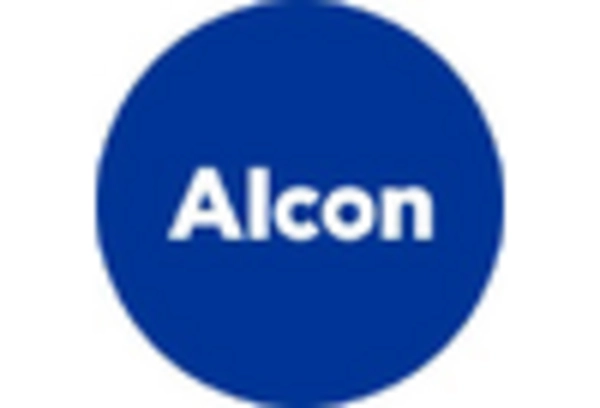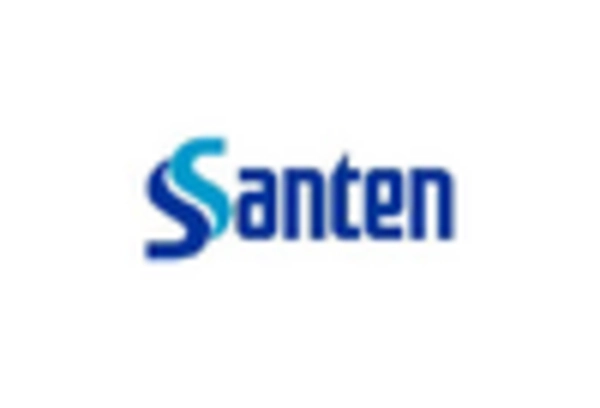Increasing Aging Population
The aging population in Japan is a crucial driver for the retinal drugs market. As individuals age, the prevalence of age-related eye diseases, such as age-related macular degeneration (AMD) and diabetic retinopathy, tends to rise. According to recent statistics, approximately 30% of individuals aged 65 and older in Japan experience some form of visual impairment. This demographic shift is likely to increase the demand for effective retinal therapies, thereby propelling the growth of the retinal drugs market. Furthermore, the Japanese government has recognized the need for enhanced healthcare services for the elderly, which may lead to increased funding and support for research and development in this sector. Consequently, the combination of an aging population and supportive healthcare policies could significantly impact the retinal drugs market in Japan.
Advancements in Research and Development
Innovations in research and development are pivotal for the retinal drugs market. Japan is home to several leading pharmaceutical companies and research institutions that are actively engaged in developing novel therapies for retinal diseases. The investment in R&D has been substantial, with expenditures reaching approximately ¥1 trillion in recent years. This financial commitment has facilitated breakthroughs in drug formulations and delivery mechanisms, enhancing the efficacy of treatments for conditions like diabetic macular edema and retinal vein occlusion. Moreover, collaborations between academia and industry are fostering an environment conducive to innovation, which may lead to the introduction of new drugs in the market. As a result, advancements in R&D are expected to play a significant role in shaping the future of the retinal drugs market in Japan.
Economic Factors and Healthcare Expenditure
Economic factors significantly influence the retinal drugs market in Japan. The country has a robust healthcare system, with healthcare expenditure accounting for approximately 10% of its GDP. This level of investment in healthcare is likely to support the availability and accessibility of retinal drugs. Furthermore, the Japanese government has implemented policies aimed at controlling healthcare costs while ensuring that patients have access to necessary treatments. The introduction of health insurance schemes that cover a wide range of retinal therapies may enhance patient access to these drugs. Additionally, the economic stability of Japan allows for continued investment in healthcare infrastructure, which could further bolster the retinal drugs market. As economic conditions remain favorable, the potential for growth in the retinal drugs market appears promising.
Growing Awareness and Screening Initiatives
There is a notable increase in awareness regarding retinal diseases in Japan, which is driving the retinal drugs market. Public health campaigns and initiatives aimed at educating the population about the importance of regular eye examinations are gaining traction. For instance, the Japanese Ophthalmological Society has launched several programs to promote early detection and treatment of retinal conditions. This heightened awareness is likely to lead to an increase in screening rates, which could result in earlier diagnosis and treatment of retinal diseases. Consequently, as more individuals seek medical attention for their eye health, the demand for retinal drugs is expected to rise. This trend indicates a positive outlook for the retinal drugs market, as proactive health measures are likely to enhance treatment outcomes and patient quality of life.
Regulatory Environment and Approval Processes
The regulatory environment in Japan plays a significant role in shaping the retinal drugs market. The Pharmaceuticals and Medical Devices Agency (PMDA) has established streamlined approval processes for innovative therapies, which may facilitate quicker access to new treatments for patients. Recent reforms have aimed to reduce the time required for drug approval, potentially allowing new retinal drugs to reach the market faster. This regulatory support is crucial, especially for therapies targeting serious retinal conditions that require urgent intervention. Additionally, the Japanese government has been known to provide incentives for the development of orphan drugs, which could further stimulate innovation in the retinal drugs market. As a result, a favorable regulatory landscape may encourage pharmaceutical companies to invest in the development of new retinal therapies.

















Leave a Comment